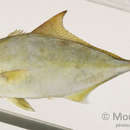Diagnostic Description
provided by Fishbase
This species is distinguished by the following characters: upper jaw posterior very broad, extends to level of middle of pupil; gill rakers (excluding rudiments) decreasing slightly in number with growth, 6-9 + 18-20 = 24 -29 in 2-7 cm FL individuals, but 22-26 in fish larger than 20 cm FL; length of dorsal-fin lobe about 1.3 to 1.6 times longer than pectoral fins and 18 to 22% of fork length; caudal peduncle with dorsal and ventral grooves present; first pterygiophore of anal fin straight in specimens larger than about 10 cm fork length. Colour: dorsal brown or silvery blue-green to olivaceous, ventral paler or silvery with brassy or lavender reflections, with yellow midlateral stripe usually present, and an oblique, dark yellowish brown band from nape through eye to edge of upper lip, the nuchal bar often persistent in adults (may be absent); juveniles (2-18 cm fork length) with dark nuchal bar and 6 dark body bars, each with a light narrow irregular area through their centre vertically, that do not extend into the membranes of the second dorsal and anal fins, and a seventh bar at the end of caudal peduncle; fins dark or yellowish grey except pelvic fins, white ventrally (Ref. 9894, 90102).Description: Body elongated, moderately deep, slightly compressed; upper profile more convex than lower; teeth minute in a broad band in both jaws; D VII + I,27-33; A II + I,18-22; pelvic fins longer than pectoral fins; no scutes (Ref. 9894, 90102).
- Recorder
- Cristina V. Garilao
Morphology
provided by Fishbase
Dorsal spines (total): 8; Dorsal soft rays (total): 27 - 33; Analspines: 3; Analsoft rays: 18 - 22; Vertebrae: 24
- Recorder
- Cristina V. Garilao
Trophic Strategy
provided by Fishbase
Inhabits outer reef slopes and offshore banks to 160 m or more (Ref. 26235); also found in coral reefs (Ref. 58534). Adults are pelagic and demersal (Ref. 9283). Young often seen around floating objects (Ref. 4887, 48635). Feeds mainly on fishes, but also on invertebrates. Piscivore (Refs. 57615, 127989). Macro-carnivore (Ref. 126840). Feeds during the day and at night (diurnal and nocturnal) (Ref. 4887).
Biology
provided by Fishbase
Adults are benthopelagic in outer reef slopes and offshore banks to 160 m or more. They form small groups (Ref. 9283, 26235, 58302). Young often seen around floating objects (Ref. 4887, 48635). They feed mainly on fishes, but also on invertebrates. Eggs are pelagic (Ref. 4233). Marketed fresh and salted or dried (Ref. 9283). May cause ciguatera poisoning, particularly in coral reef areas (Ref. 5217). Uncommon on East Indian reefs but occasionally found in cool upwelling areas of Lesser Sunda Islands of Indonesia (Ref. 90102).
Importance
provided by Fishbase
fisheries: commercial; gamefish: yes

